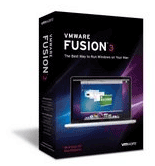 Was it really only a little over three years ago that the formerly fanciful notion of being able to run Windows apps within OS X without major limitations became reality? Today, archrivals Parallels Desktop and VMware Fusion continue to undergo aggressive upgrades aimed at making the virtualization of Windows on Macs even more powerful, seamless, and simple. And today, VMware is announcing that it’s taking preorders for VMware Fusion 3, which will ship on October 27th.
Was it really only a little over three years ago that the formerly fanciful notion of being able to run Windows apps within OS X without major limitations became reality? Today, archrivals Parallels Desktop and VMware Fusion continue to undergo aggressive upgrades aimed at making the virtualization of Windows on Macs even more powerful, seamless, and simple. And today, VMware is announcing that it’s taking preorders for VMware Fusion 3, which will ship on October 27th.
I haven’t had any hands-on time with the new version yet, but the list of features that VMware has revealed leaves me anxious to get my mitts on it:
- Snow Leopard support, including a 64-bit engine and support for OS X’s 64-bit kernel.
- Full support for Windows 7, including the Aero interface and Flip 3D task switching and better support for DirectX and OpenGL graphics.
- A migration utility that lets you import a real PC’s Windows installation over the network. (Parallels introduced something similar in August, but did so in a separate version of the product that does the job over a bundled USB cable.)
- A menu for your Windows apps that appears on the right-hand side of OS X’s Menu Bar, reducing or eliminating the need to use Windows’ Start menu and Taskbar.
- A more efficient engine that’s less taxing on a Mac’s CPU, can run Windows well in 1GB of RAM, and reduces battery drain, according to VMware. I’m especially happy about that last point–my biggest beef with both Fusion and Parallels is the dramatically reduced battery life I get when they’re running. (Still to be determined: How this version’s speed compares to Parallels–the Parallels folks understandably like to tout this MacTech story that shows their product outperforming Fusion 2 in most tests.)
In all, VMware says that Fusion 3 has more than fifty new features. It’ll cost $79.99 for new users; an upgrade version will be $39.99. A few screens supplied by VMware after the jump.

 For more than two years now, my primary computing platform has been Apple’s OS X with a virtualized copy of Windows XP and/or Vista running inside it. I started running the first program that could virtualize Windows on a Mac,
For more than two years now, my primary computing platform has been Apple’s OS X with a virtualized copy of Windows XP and/or Vista running inside it. I started running the first program that could virtualize Windows on a Mac,